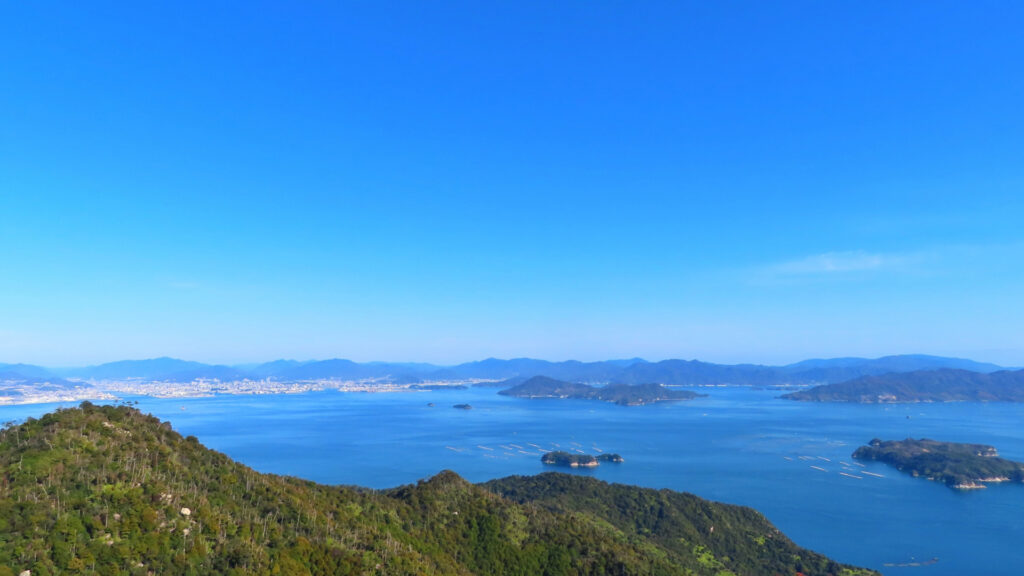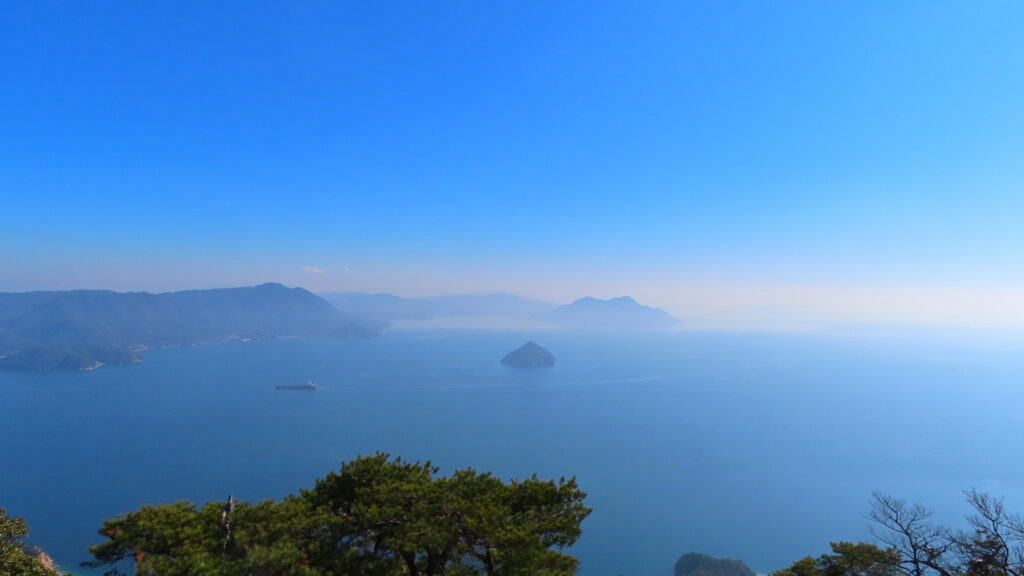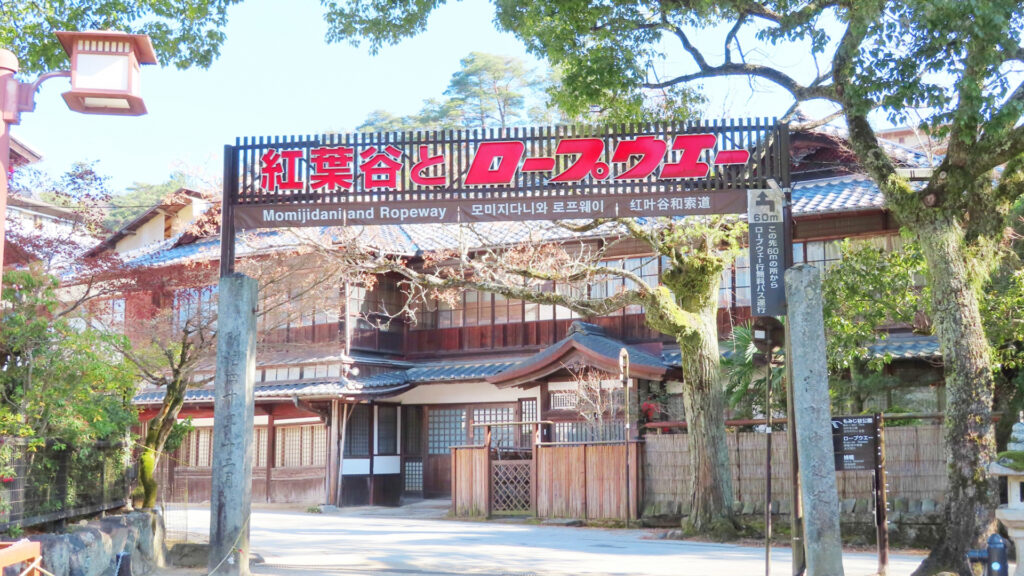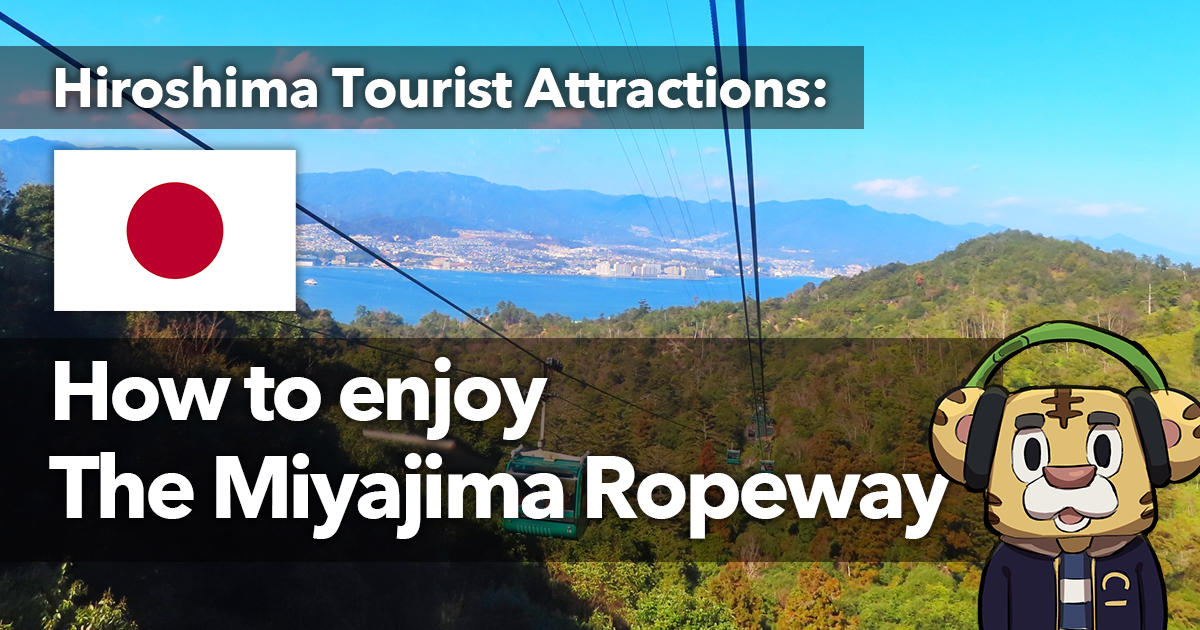Introduction

The Miyajima Ropeway offers a wonderful experience at Miyajima (Itsukushima), a beautiful tourist destination located in Hiroshima Prefecture, Japan. Miyajima is home to Itsukushima Shrine, a UNESCO World Heritage Site, and is a popular destination for many tourists throughout the year. The Miyajima Ropeway is one of the best ways to enjoy the natural beauty and spectacular views.
The Miyajima Ropeway is a gondola that connects Momijidani Station to Shishi-iwa Station, offering a comfortable ride with beautiful views. The 1.5-km-long aerial walk offers a spectacular view of the changing seasons, especially during the cherry blossom season in spring and the autumn foliage season in fall. The ropeway provides a panoramic view of the Seto Inland Sea and its surrounding islands, as well as a distant view of the city of Hiroshima, making it ideal for taking pictures.
Once you reach Shishi-iwa Station, a hiking trail extends from there to the top of Misen (Mt. Misen), and the panoramic view from the summit is worth seeing. On a clear day, the view extends as far as Shikoku and the distant mountains of Honshu, making it an unforgettable experience for visitors. The summit of Mt. Misen is also dotted with numerous historical temples and power spots, allowing visitors to enjoy history and nature at the same time.
This article details how to enjoy the Miyajima Ropeway. It covers how to use the ropeway, sightseeing highlights, the best time to visit, and access information to help you plan your visit to Miyajima. Take the Miyajima Ropeway and enjoy the natural beauty and historical charm of Miyajima to the fullest.
History and Culture of Sightseeing Destinations
Miyajima is located in Hiroshima Prefecture, Japan, and its history and culture are extremely rich and varied. This section details the historical background and cultural characteristics of Miyajima.
Historical Background

Miyajima has been revered as a sacred place since ancient times. The particularly famous Itsukushima Shrine is said to have been founded in 593. The shrine flourished during the Heian period (794-1192) and still attracts visitors today with its magnificent architecture and beautiful scenery. Itsukushima Shrine features a large red torii gate floating on the sea, and at high tide, the shrine appears to float on the sea, a truly postcard-perfect sight.
Itsukushima Shrine is registered as a World Heritage Site and is a place where visitors can deeply experience Japanese history and culture. The shrine flourished along with the prosperity of the Heike clan and was visited by warriors and aristocrats. Itsukushima was also revered as the guardian deity of the Mori family after Motonari Mori won a major battle here during the Warring States period.
Cultural Features
Along with its natural beauty, Miyajima boasts a rich culture. Many festivals and traditional events are held every year, centering on Itsukushima Shrine. For example, the Miyajima Kangensai, a traditional festival held every June, attracts many tourists with its Gagaku (ancient Japanese court music) performances and Shinto rituals performed on board a boat.
Misen (Mt. Misen) on Miyajima has long been the object of religious worship, and many ascetic practitioners have practiced asceticism on this mountain. The summit of Mt. Misen is dotted with old Buddhist temples and places of ascetic practice, providing a mystical atmosphere.
Furthermore, the traditional crafts of Miyajima are not to be missed. In particular, it is famous for the production of rice scoopers, and there are many workshops on the island. Miyajima rice-crunching ladles are widely popular as good luck charms, and are also popular as souvenirs.
Miyajima’s cuisine is also part of its culture. Miyajima oysters are especially fresh and delicious, and can be enjoyed at many restaurants. Momiji manju, a traditional sweet, is also popular and loved by visitors.
Miyajima is a special place that combines history, nature, and culture. A visit will give you a deep understanding of Japan’s rich history and culture, and will be a memorable experience.
Places to visit
The Miyajima Ropeway offers a wonderful experience to enjoy the beauty of nature and history of Miyajima all at once. Here are some suggestions for the best time of year to visit Miyajima Ropeway, main attractions, and things to keep in mind when sightseeing.
Suggested times of year
The best times to visit Miyajima are spring and fall. In spring (March to May), the cherry blossoms are in full bloom and the entire mountain turns pink. The view from Mt. Yayama is especially exceptional, offering a beautiful contrast between the cherry blossoms and the Seto Inland Sea. In autumn (September to November), the autumn leaves are at their best and the mountains are dyed in vivid reds and yellows. The area around Momijidani Park is a particularly popular spot, offering visitors a spectacular view.
Major tourist attractions and popular spots
The Miyajima Ropeway connects Momijidani Station to Shishi-iwa Station, and offers the following main attractions.
- Momiyadani Park: Known for its beautiful autumn foliage, the park is visited by many tourists during the cherry blossom season in spring and the autumn foliage season in fall. It is a great place to stroll before heading to Momijidani Station.
- Shishi-iwa Observatory: Upon arrival at Shishi-iwa Station, the observatory offers a spectacular view of the Seto Inland Sea. On a clear day, you can see as far as Shikoku and the mountains of Honshu.
- Miyama Summit: From Shishi-iwa Station, visitors can take a hiking trail to the summit of Mt. The summit is home to historical temples and power spots that provide visitors with a sacred atmosphere. In particular, visitors can see a fire that has been burning for more than 1,200 years at the sacred fire hall.
- Itsukushima Shrine: After getting off the Miyajima Ropeway, be sure to visit Itsukushima Shrine. This shrine is famous for its large red torii gate floating on the sea and is a World Heritage Site. You can enjoy the changing scenery as the tide comes in and out.
Points to note at sightseeing spots
When using the Miyajima Ropeway, it is advisable to keep the following cautions in mind.
- Avoid crowds: The ropeway is extremely crowded, especially during the season of autumn leaves and cherry blossoms. By visiting early in the morning or on a weekday, you can avoid the crowds and enjoy your visit at a leisurely pace.
- Watch out for the weather: The weather in the mountains can be changeable, so check the weather forecast before you visit and dress appropriately. Bring rain gear and warm clothing.
- Prepare to Hike: The hike to the summit of Mt. Bring comfortable shoes, plenty of drinking water, and a comfortable pace.

Access
Access to the Miyajima Ropeway is very convenient and can be easily reached by many modes of transportation. Below are some of the major access methods.
Access from Hiroshima City
Access to Miyajima from Hiroshima City is as follows.
By train and ferry
- Take the JR West Japan train from Hiroshima Station to Miyajimaguchi Station on the Sanyo Main Line, about 30 minutes.
- From Miyajima-guchi Station, walk about 5 minutes to Miyajima Ferry Terminal.
- The ferry will take you across to Miyajima in approximately 10 minutes. The Miyajima Ferry operates frequently. After arriving at Miyajima, walk to Momijidani Station on the Miyajima Ropeway. It is approximately a 20-minute walk to Momijidani Station.
If you take the Hiroden (Hiroshima Electric Railway) train.
- From Hiroshima City, take Hiroden (streetcar) Line No. 2 or No. 6 to Miyajima-guchi Station (about 70 minutes).
- From Miyajimaguchi Station, take the ferry to Miyajima as mentioned above.
Access from Hiroshima Airport
Access from Hiroshima Airport to Miyajima is as follows.
To take the limousine bus and train.
- From Hiroshima Airport, take the limousine bus bound for Hiroshima Station, which takes approximately 50 minutes.
- From Hiroshima Station, take the JR Sanyo Line to Miyajima-guchi Station and take a ferry to Miyajima.
Taking a taxi.
- If you take a cab directly from Hiroshima Airport, it takes approximately 60 minutes to arrive at the Miyajimaguchi Ferry Terminal. The fare is approximately 10,000 yen, but is convenient if you are traveling with several people or have a lot of luggage.
Getting Around Miyajima
After arriving at Miyajima, the Miyajima Ropeway Momijidani Station can be reached by the following means.
Walk.
- It takes about 20 minutes on foot from the ferry terminal to Momijidani Station. It is a good idea to walk slowly while enjoying the beautiful scenery.
Shuttle bus.
- A shuttle bus runs from the Miyajima Ferry Terminal to Momijidani Station. The trip takes about 10 minutes and is especially convenient if you have a lot of luggage or if walking is difficult.
Access to the Miyajima Ropeway is easy and comfortable by train, ferry, or cab from Hiroshima City or Hiroshima Airport. Even within Miyajima, visitors can smoothly reach Momijidani Station on foot or by shuttle bus. Take the Miyajima Ropeway and enjoy the beautiful nature and historical sites of Miyajima to the fullest.
Hours of Operation, Admission Fees
The Miyajima Ropeway is a popular spot to enjoy the beautiful scenery and spectacular views of Miyajima. Here are details about the Miyajima Ropeway’s operating hours and admission fees.

Operating Hours
Opening hours of the Miyajima Ropeway vary depending on the season. Below are the general operating hours.
- March 1 through October 31: 9:00 am to 4:00 pm (last boarding at 4:30 pm)
- November 1 through the end of February: 9:00 a.m. to 4:00 p.m. (last boarding at 4:00 p.m.)
However, hours of operation are subject to change due to weather and other conditions; therefore, it is recommended to check the official website for the latest information before visiting.
Admission Fees
Fees for the Miyajima Ropeway are different for round-trip and one-way rides. Fares for adults and children are also separated.
Round-trip Fees:.
- Adult (12 years old and over): 2,000 yen
- Children (6-11 years old): 1,000 yen
One-way Fare: Adult (12 years and older): 1,000 yen
- Adult (12 years and older): 1,100 yen
- Child (6-11 years old): 550 yen
Preschool children are free, but must be accompanied by an adult. Group discounts are available, so please inquire in advance if you plan to visit with a group.
Special Discounts
Miyajima Ropeway also offers special discounts for senior citizens and the disabled. Please check the official website for details or inquire at the local ticket counter.
Summary

The Miyajima Ropeway is a great way to enjoy the beautiful natural scenery and history of Miyajima (Itsukushima) located in Hiroshima Prefecture. Miyajima is famous for Itsukushima Shrine, a UNESCO World Heritage Site, and the ropeway allows visitors to enjoy the spectacular view of the Seto Inland Sea and the panoramic view from the top of Mount Misen (Mt. Misen). The best times to visit are spring and fall, when the cherry blossoms and autumn leaves are beautiful and the views from the park and observatory are even more attractive.
Access from Hiroshima City and Hiroshima Airport is convenient, with a variety of transportation options available, including trains, ferries, and cabs. Within Miyajima, visitors can smoothly walk or take a shuttle bus from the ferry terminal to Momijidani Station.
Highlights of the Miyajima ropeway include Momijidani Park, Shishi-iwa Observatory, and the historical temples and power spots at the top of Mt. For sightseeing, we recommend visiting early in the morning or on a weekday to avoid crowds. Also, please be aware of weather conditions and be prepared to wear comfortable walking shoes and appropriate clothing.
The Miyajima Ropeway is a wonderful attraction that allows you to enjoy the natural beauty and historical sites of Miyajima all at once. Be sure to visit at the best time of year to fully enjoy the charms of Miyajima. It is a wonderful experience that will make your trip to Miyajima even more special.



